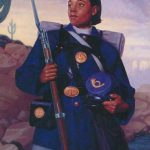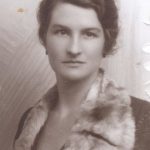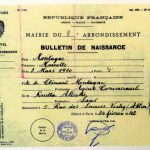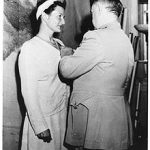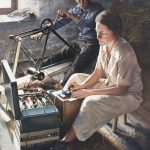Sorry this is a day late! The long holiday weekend got me all mixed up + being sick did not help at all. Thank you for reading! 🙂
- Cathay’s enlistment form. NATIONAL ARCHIVES
- Buffalo Soldiers of the 25th Infantry at Fort Keogh in Montana. LIBRARY OF CONGRESS / LC-DIG-PPMSCA-11406
- Painting of Cathay Williams by William Jennings from the U.S. Army Profiles of Bravery
Cathay Williams
Born: September 1844 Died: 1893
What she did: The first African-American woman to enlist in the Army
Facts:
- Cathay Williams was born in Independence Missouri in September of 1844.
- She was a slave. Her father was a free man, but her mother was a slave.
- Growing up, Cathay worked as a house slave on the Johnson plantation outside of Jefferson City, MO.
- When the American Civil War broke out in 1861, Union soldiers occupied the city.
- At this time, the Union viewed captured slaves as “contraband” and many were forced to serve in the military serving as cooks, nurses, and other support roles.
- At 17 years old, Cathay was forced to serve in the 8th Indiana Volunteer Infantry Regiment.
- During her time with them, Cathay marched with the 8th Indiana through Arkansas, Louisiana, and Georgia.
- She also witnessed African-American men serving as soldiers. When the Civil War ended, Cathay was working at Jefferson Barracks.
- Cathay decided to officially join the U.S. Army in 1866.
- There was just one little problem; women were not allowed to serve in the military.
- To get around this small technicality, Cathay created the perfect alternate male persona. Cathay Williams enlisted in the U.S. Army under the name, William Cathay.
- After passing what was certainly a very casual medical exam, Cathay enlisted for a 3-year engagement and was assigned to the 38th United States Infantry Regiment.
- This made her the first African American woman to enlist in the United States Army and the only one we know of who served in drag.
- During her service, Cathay contracted smallpox and was hospitalized. Cathay rejoined her unit in New Mexico when she recovered.
- Unfortunately, a combination of the bout of smallpox, New Mexico heat, and physical strain of her service led to frequent illness. After being hospitalized MULTIPLE TIMES, a doctor finally noticed she was a woman.
- The doctor notified the post commander and Cathay was subsequently honorably
discharged on October 14th , 1868 after two years of service. - After her discharge from the military, Catahy joined the Buffalo Soldiers. The Buffalo Soldiers were a group of African American soldiers who primarily served on the western frontier after the American Civil war. They primarily went after thieves, rustlers, and protected those traveling west.
- Cathay bounced around a bit and eventually married, but the marriage ended poorly after the son of a bitch stole money and a team of horses from her.
- Cathay promptly had him arrested.
- Cathay held a few positions, including as a cook and a seamstress. In fact, it was while working as a seamstress that the word got out about Cathay’s story.
- A reporter from St. Louis had heard rumors of her service and interviewed her. Her story was published in the St. Louis Daily Times on January 2nd , 1876.
- Between 1889 and 1890, Cathay entered the hospital for some health issues. She applied for a disability pension based on her service. Although there was precedent for granting a pension to female soldiers, Cathay was denied.
- In 1893, Cathay’s health issues escalated. She suffered from neuralgia and diabetes which required for all of her toes to be amputated meaning she had to walk with a crutch for the rest of her life. We don’t know when she died, but it’s likely it was soon after her disability claim was denied.
LEGACY
- Over 400 women (that we know of) served in the Civil War disguised as mile soldiers, but Cathay was the first African American woman to enlist in the U.S. Army and was the only known female Buffalo Soldier.
- Cathay felt the call to serve and wouldn’t let a silly little think like patriarchal bullshit stand in her way.
- Virginia Hall Photo Courtesy of CIA
- French identification certificate for ‘Marcelle Montagne’ forged by OSS Wikipedia
- Virginia Hall receiving the Distinguished Service Cross in 1945 from OSS chief General Donovan
- Photo hung in CIA head quarters. Les Marguerites Fleuriront ce Soir by Jeffrey W. Bass
Virginia Hall
Born: 1906 Died: 1982
What she did: The Most Dangerous Spy of All, aka The Limping Lady
Facts:
- Virgina was born in Baltimore, Maryland, the daughter of Barbara Virginia Hammel and Edwin Lee Hall.
- Beneath her passion for leading was a streak of independence and self-confidence.
- She went to the prestigious Radcliffe College and Barnard College (Columbia University),where she studied French, Italian and German (and became fluent in all also learning some Russian).
- She continued her studies in Paris and at the Konsularakademie in Vienna, where she earned a diploma in economics and international law.
- With help from her parents, she traveled the Continent and studied in France, Germany, and Austria.
- Finally she landed an appointment as a Consular Service clerk at the American Embassy in Warsaw, Poland, in 1931.
- She grew restless and having ambition sought to join the diplomatic corps, which had very few women at the time.
- In 1932 when she accidentally shot herself in the left leg while hunting birds in Turkey. After gangrene set in, Virginia lost a portion of her left leg, just below the knee.
- Virginia learned to walk with the prosthetic limb, which she nicknamed “Cuthbert.”
- This was a clunky appendage made of painted wood with its aluminum foot, weighed more than 7 pounds. It was attached by leather belts wrapped around Virginia’s waist.
- The State Department had strict rules against employees with disabilities joining the diplomatic corps, and Virginia was furious when she was barred from testing.
- Her preferred career path was blocked, and she resigned from the Department of State in 1939. Thereafter she attended graduate school at American University in Washington, DC.
- She joined the Ambulance Service before the fall of France but after the Germans rolled through Paris in June 1940, her and a friend fled on a bike taking turns on the handle bars, she insisted on pedaling too despite her leg.
- She retreated to London and when a vacancy opened at the US War Department, and she accepted a position as a code clerk.
- Prime Minister Winston Churchill had just established the Special Operations Executive (SOE) to “set Europe ablaze” which sent her back to France in August 1941.
- The SOE recruited Virginia to be its first woman resident agent in France. Using forged documents, false names, and working undercover as a reporter for the New York Post, Virginia established in August 1941 a headquarters in the Haute Loire Department between the cities of Toulouse and Lyon.
- Her mission, code-named Geologist-5, was to provide SOE with information on Vichy France, including reports on political developments, economic conditions, and the popular will to resist.
- Virginia went beyond her charter and proved adept at recruiting spies. She grew her agent network, code-named Heckler, into an important logistical hub.
- Heckler, first on the ground, was centrally located. Virginia became an expert at support operations—organizing resistance movements; supplying agents with the money, weapons, and supplies; helping downed airmen to escape; offering safe houses and medical assistance to wounded agents and pilots.
- She also developed a specialty: planning and executing jailbreaks. One of her agents, a local doctor named Jean Rousset, established an asylum for the mentally ill to provide medical support and hide escapees until safe passage from France could be found.
- Being the nerve center made Virginia a Target as well. According to Dr. Dennis Casey of the U.S. Air Force Intelligence Agency, the French nicknamed her “la dame qui boite” and the Germans put “the limping lady” on their most wanted list.
- Lyon’s Gestapo chief, Klaus Barbie, who never knew Virginia’s true name or nationality, caught wind of her activities and was reported to have said, “I would give anything to get my hands on that limping Canadian Bitch.”
- Of the more than 400 SOE agents ultimately sent to France, 25 percent didn’t return—many were executed on discovery—others survived brutal torture or were shipped to concentration camps.
- With so many networks rolled up, Virginia became a more important source and conduit for information. When Virginia heard a French network in Paris codenamed Gloria was desperate to send reports and microfilm of German naval facilities to SOE London, she agreed to help.
- She didn’t know that the leader of Gloria had been captured, tortured, and ultimately killed and that the Abwehr (German Intelligence Agency) controlled his organization. The Abwehr sent its agent—a Catholic priest turned informant, Abbé Robert Alesh—to courier tampered microfilm to Heckler’s drop at Dr. Rousset’s office.
- Virginia didn’t trust the abbé and sensed the coming danger: agent networks were collapsing all around and both the Abwehr and Gestapo were closing in.
- In September 1942, she sent a message to London: “My address has been given to Vichy . . . I may be watched . . . my time is about up.”
- The Gestapo began a concerted focus on Lyon, where they noted a spike in escaped prisoners, sabotage efforts, and disappearances of downed pilots, much associated with the “Limping Lady.”
- Barbie captured many of the HECKLER operatives in the ensuing months, Hall escaped the country in the knick of time.
- Hall knew she had to leave immediately and narrowly escaped by train from Lyon to Perpignan, then walked over a 7,500 foot pass in the Pyrenees to Spain, covering up to 50 miles over two days in considerable discomfort.
- Before making her escape, she signalled to SOE that she hoped Cuthbert would not give trouble on the way. The SOE, not understanding the reference, replied, “If Cuthbert troublesome, eliminate him”.
- After arriving in Spain she was arrested by the Spanish authorities for illegally crossing the border, but the US Embassy eventually secured her release.
- Virgina wanted to return to France however, the British refused her request, because she was too well-known to the Gestapo.
- After working for SOE for a time in Madrid, she returned to London in July 1943 where she was quietly made an honorary Member of the Order of the British Empire (MBE).
- Virginia joined the U.S. Office of Strategic Services (OSS) Special Operations Branch in March 1944 and asked to return to occupied France.
- The OSS promptly granted her request and landed her from a British MTB in Brittany (her artificial leg having kept her from parachuting in) with a forged French identification certificate for Marcelle Montagne. Codenamed “Diane”, she eluded the Gestapo and contacted the French Resistance in central France.
- Hall disguised herself as a plump, elderly woman with a limp, changed her walk to a shuffle, and had the fillings of her teeth re-done to match French dentistry. Hall took up the persona of Marcelle Montagne, a farmhand in a the small village of Crozant in central France where she tended cows, made cheese and assisted the farm owner.
- While appearing to be a local peasant, she collected vital intelligence about German troop movements, established contacts with the resistance and radioed London. She also sold cheese to soldiers as a cover for collection. She would they relay information back to London sometimes using a bicycle to get power.
- Despite her operational security and solid cover, she was interrogated and several local farmers were killed—their heads placed on spikes as a demonstration of what would happen if they were found collaborating with the enemy.
- Seeing the increased risk of being discovered, Hall radioed London that “the wolves are at the door,” and fled to the town of Cosne, near Paris. Once there, she realized Cosne was a valuable operating base leading up to and after D-Day and set to work immediately.
- She mapped drop zones for supplies and commandos from England, found safe houses, and linked up with a Jedburgh team after the Allied Forces landed at Normandy.
- Allied troops overtook her small band in September. With the Germans beginning a retreat, Hall worked her way back to the Haute Loire, where she organized several thousand Maquis, blew up bridges, and conducted other sabotage operations to support the Allies’ D-Day invasion.
- During a two-month period in mid-1944, Hall sent 37 intelligence reports, oversaw 27 parachute drops of material for the French resistance, coordinated the efforts of 1,500 resistance fighters, oversaw innumerable attacks resulting in more than 170 Germans killed and 800 captured, managed dozens of acts of sabotage that disrupted German logistics and reinforcements, and integrated a joint SOE-OSS operational team into her area of operations.
- She was awarded the Distinguished Service Cross, the only civilian woman in the Second World War to do so.
- She refused all but a private ceremony with OSS chief Donovan—even a presentation by President Truman. By this time Virginia had joined the CIA and thought the publicity would blow her cover.
- After the war, Virginia, because she spoke Italian fluently, she was dispatched to Venice, where for several years she collected and transmitted economic, financial, and political intelligence with special emphasis on the Communist movement and its leaders.
- She then worked for the National Committee for a Free Europe (NCFE), a CIA front organization associated with Radio Free Europe.
- In 1950, Hall married former OSS agent Paul Goillot when she had met in france, but he had arrived after D-Day and found no Germans to help fight as most of the resistance groups disbanded as they troops pulled out.
- After the war, the 40-year-old Hall was eager to remain in the intelligence business. In 1951, she joined the Central Intelligence Agency.
- She began working as an intelligence analyst on French parliamentary affairs. She worked alongside her husband as part of the Special Activities Division.
- One of a handful of relatively senior women in the clandestine service, she worked in various elements of CIA until her mandatory retirement in 1966 at the age of 60.
- Virginia Hall left no memoir, granted no interviews, and spoke little about her overseas life—even with relatives.
- Virginia Hall Goillot died at the Shady Grove Adventist Hospital in Rockville, Maryland, on 8 July 1982, aged 76.
Legacy
- Hall was posthumously inducted into the Maryland Women’s Hall of Fame in 2019.
- In 2006, the CIA hung an oil painting of Hall that depicts her inside a barn in southern France in 1944, using a suitcase radio powered by an automobile generator and bike parts to transmit messages to London.
- Recently, the CIA also named a training facility after her called, “The Virginia Hall Expeditionary Center.”
- She has had several book written about her one that may soon become a movie.


